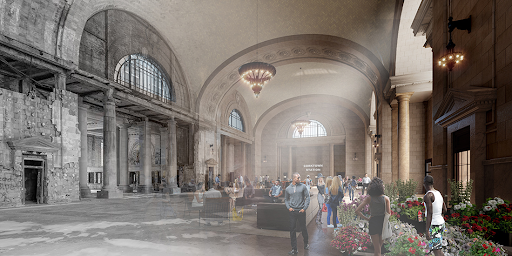
Apr
Adaptive Reuse Architecture: Giving Old Buildings New Life
Abandoned buildings, scattered across cities and rural areas alike, often embody rich history and untapped potential. Thanks to the emerging architectural approach known as adaptive reuse, these structures can be given a new lease on life. Simply put, adaptive reuse is the practice of “repurposing an existing structure for a new use“, breathing new life into them and serving the needs of the surrounding community. From transforming a former church into a bustling restaurant to converting an old train station into office space, adaptive reuse architecture offers a unique way to revitalise historical buildings and create sustainable, functional spaces. Moreover, due to its sustainability, cultural preservation, and economic advantages, adaptive reuse is experiencing a surge in popularity within the construction industry, as highlighted by UGREEN, a sustainable design consultant.

(Source: Redshift by Autodesk)
Why is Adaptive Reuse Important?
- Preserves cultural heritage: In areas with a wealth of historic architecture, adaptive reuse plays a vital role in preserving cultural heritage. Rather than allowing culturally significant sites to decay or be demolished to make way for new structures or parking lots, adaptive reuse breathes new life into these buildings. By repurposing them, we honour their history and ensure that future generations can appreciate their architectural and cultural value.
- Reduces urban sprawl: Urban land is often occupied by old buildings or deemed too expensive for new construction. As a result, builders are forced to seek new sites outside city centres, leading to urban sprawl—a term used to describe the unrestricted expansion of urban areas. Urban sprawl brings forth numerous issues, including increased air pollution, environmental impacts, traffic congestion, higher infrastructure costs, and social isolation. Adaptive reuse presents a viable solution to combat urban sprawl by utilising existing structures, thus reducing the need for new developments on the outskirts of cities. Consider the fascinating transformation of a cheese factory in Arkansas as a prime example. Previously utilised for processing cheese under the Kraft Foods brand, this facility has since been reborn as a prestigious modern art museum in the United States.
- Creates a new community icon: Beyond its practicality, adaptive reuse architecture yields remarkable aesthetic results. By repurposing historical buildings, unique and visually stunning spaces can be created. For instance, the Tate Modern art gallery in London resides within the former Bankside Power Station, an electricity plant that ceased operation. Through adaptive reuse, this decommissioned plant was transformed into an iconic art gallery, becoming a cultural landmark and adding a distinct charm to the cityscape.
What Are the Benefits of Adaptive Reuse?
Adaptive reuse offers many advantages for building projects, including:
- Cost-effectiveness. Compared to traditional building methods, adaptive reuse projects offer significant cost savings. While material costs continue to rise, labor costs remain relatively stable. Moreover, the avoidance of demolition expenses, which can be a substantial portion of a construction budget, adds to the financial advantages. These benefits are backed by a report from Trade & Industry Development, which states that ‘from a cost perspective, a complete building rehabilitation costs about 16 percent less in construction costs and 18 percent less in construction time than new construction.’ The positive impact extends beyond cost savings, as highlighted by Deloitte’s findings that ‘sustainability investments result in even broader payback in the form of higher rental income and occupancy, improved valuation, easier and lower-cost financing, lower operating expenses, property tax rebates, and discounts on insurance premiums.’ This creates a win-win scenario for developers embracing adaptive architecture, providing both financial benefits and sustainable outcomes.
- Faster construction. Rehabilitating an existing building can often be completed faster than building a new one from scratch. With minimal refurbishment, many parts of an old building may already be habitable, allowing owners to start using the space for business even while the project is ongoing.
- Community appeal. Adaptive reuse projects are popular with communities because they preserve historic buildings and create unique landmarks that add character and interest to the neighbourhood. Repurposing older buildings can also be a draw for businesses, whether it’s a restaurant, apartment building, or shopping mall.
Adaptive reuse is a process used by both aspiring homeowners and commercial builders to turn unconventional or historic buildings into something new. The general steps involved in adaptive reuse are:
- Assessment: Hire a professional to assess the old structure to ensure it’s a good candidate for adaptive reuse. Also, research local zoning laws to ensure the idea is viable.
- Neighborhood Survey: Survey the area around the building to consider whether the community would be interested in the type of building planned, pedestrian patterns, transportation options, and surrounding homes and businesses.
- Budget: Have a contractor estimate the project’s cost and determine whether or not those costs align with the ideal budget.
- Team: Hire professionals, such as a restoration contractor, a design professional (preferably an architect or architecture firm specializing in adaptive reuse), or a historic conservation professional, to ensure the project’s success.
- Create Plans: With the team, create official plans, deciding which elements to reuse or replace, considering the building’s repair history to determine which areas need attention.
- Construction: Begin construction taking special care to avoid damaging or destroying viable materials, avoiding harsh surface treatments or haphazard demolition approaches that could damage parts of the building.
In conclusion, adaptive reuse architecture offers a compelling solution for reviving historic buildings and transforming them into functional, sustainable spaces. It preserves cultural heritage, reduces urban sprawl, and creates unique community icons. With cost-effectiveness, faster construction timelines, and community appeal, adaptive reuse projects bring together the elements of preservation, creativity, and practicality. By embracing this approach, we can breathe new life into our built environment while honouring the past and building a better future.
Done By: Rejina Khar, Zarif Ong & Elly Ken
Source: MasterClass, Redshift by Autodesk, Inhabitat, Currituck Economic Development, Deloitte, Trade & Industry Development & UGREEN

